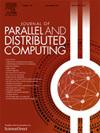A scalable tensor-based MDTW approach for multi-modal time series patterns clustering
IF 4
3区 计算机科学
Q1 COMPUTER SCIENCE, THEORY & METHODS
引用次数: 0
Abstract
Multi-modal Time Series (MTS) is a vital ingredient to Predictive Multi-modal Artificial Intelligence (PMAI). MTS systems capture varying temporal modalities and their inherent dependencies for their accurate analytics. However, efficiently exploring these cross-modalities relationships is a challenging research due to their complexity facets and information redundancies. MTS patterns' pairwise similarity measures precede PMAI. Multi-modal Dynamic Time Warping (MDTW) is frequently explored to quantify similar MTS. Yet, it's reliant on the orthogonal conditioned local similarity measures that ignore the contributions of MTS' underlying structural relationships in the warping process and, hence, susceptible to unrealistic matching. This paper addresses the setbacks by recommending a scalable MTS recognition model, named Tensor-Slices Distance (TSD)-based MDTW (TSD-MDTW), that's subsequently advanced to two more distinct models termed Weighted modality and TSD (WmTSD-MDTW) and TSD-Mahalanobis (TSDMaha-MDTW). To quantify an alignment's cost, TSD-MDTW incorporates intrinsic spatial dependencies between modalities' coordinates, while WmTSD-MDTW relaxes information redundancies through weighing modalities based on information richness, whereas TSDMaha-MDTW embodies modalities dependencies and their coordinates' innate spatial dependencies. Besides, it proposes a scalable Tensor-based DTW (TDTW) model that re-formulates MDTW into multiple dimensions that are found paralleling warping processes. Theoretical and empirical experimental results on MTS multi-modal datasets encompassing load patterns and meteorological modalities reveal TDTW's efficiency and proposals' superior performances in terms of cluster compactness and separation over MDTW employing the state-of-the-art local similarity measures.
多模态时间序列模式聚类的基于可伸缩张量的MDTW方法
多模态时间序列(MTS)是预测多模态人工智能(PMAI)的重要组成部分。MTS系统捕获不同的时间模式及其固有的依赖关系,以便进行准确的分析。然而,由于其复杂性和信息冗余性,有效地探索这些跨模态关系是一项具有挑战性的研究。MTS模式的两两相似性度量先于PMAI。多模态动态时间翘曲(MDTW)经常被用于量化相似的MTS,然而,它依赖于正交条件局部相似性度量,忽略了MTS在翘曲过程中潜在结构关系的贡献,因此容易产生不切实际的匹配。本文通过推荐一种可扩展的MTS识别模型来解决这些问题,该模型被称为基于张量-切片距离(TSD)的MDTW (TSD-MDTW),该模型随后被推进到两个更不同的模型,即加权模态和TSD (WmTSD-MDTW)和TSD- mahalanobis (TSDMaha-MDTW)。为了量化对齐成本,TSD-MDTW结合了模态坐标之间固有的空间依赖关系,而WmTSD-MDTW通过基于信息丰富度的模态加权来放松信息冗余,而TSDMaha-MDTW则体现了模态依赖关系及其坐标固有的空间依赖关系。此外,提出了一种可扩展的基于张量的DTW (TDTW)模型,该模型将MDTW重新表述为多个平行翘曲过程的维度。在包含负荷模式和气象模式的MTS多模态数据集上进行的理论和实证实验结果表明,采用最先进的局部相似度度量,TDTW在聚类紧密度和分离度方面优于MDTW。
本文章由计算机程序翻译,如有差异,请以英文原文为准。
求助全文
约1分钟内获得全文
求助全文
来源期刊

Journal of Parallel and Distributed Computing
工程技术-计算机:理论方法
CiteScore
10.30
自引率
2.60%
发文量
172
审稿时长
12 months
期刊介绍:
This international journal is directed to researchers, engineers, educators, managers, programmers, and users of computers who have particular interests in parallel processing and/or distributed computing.
The Journal of Parallel and Distributed Computing publishes original research papers and timely review articles on the theory, design, evaluation, and use of parallel and/or distributed computing systems. The journal also features special issues on these topics; again covering the full range from the design to the use of our targeted systems.
 求助内容:
求助内容: 应助结果提醒方式:
应助结果提醒方式:


